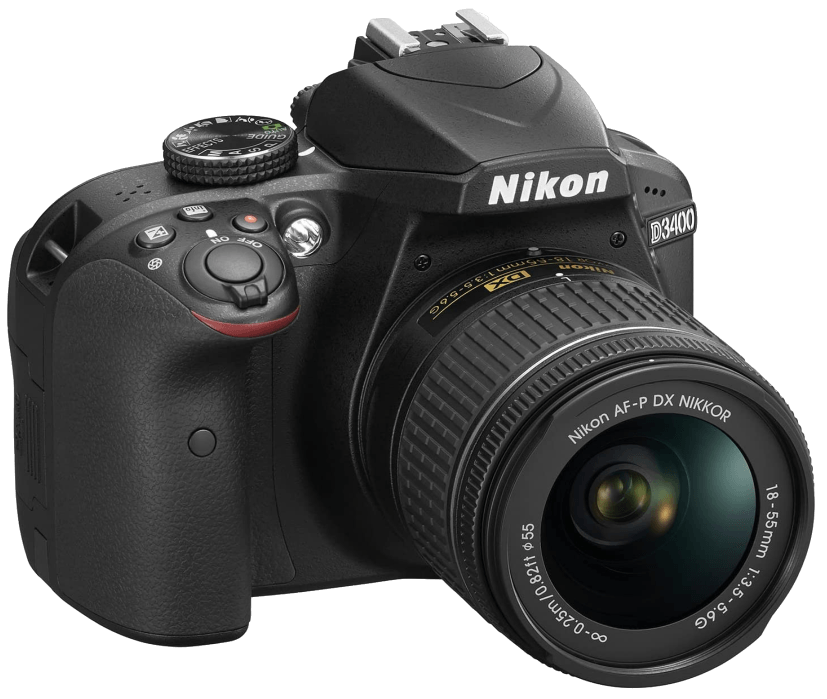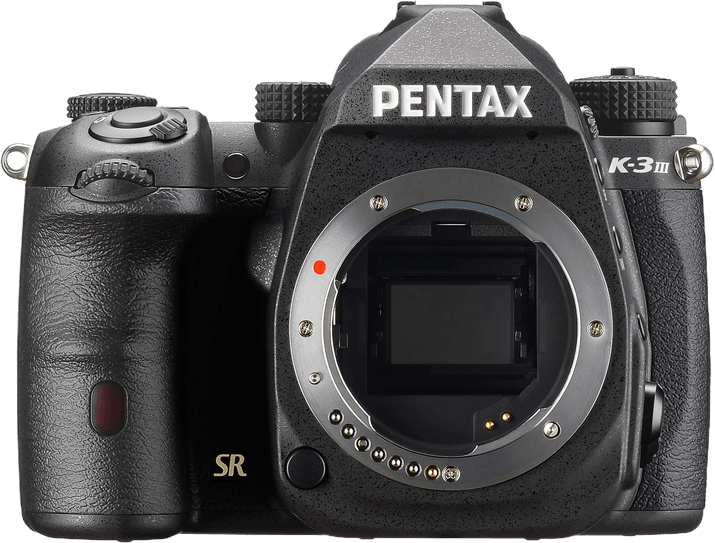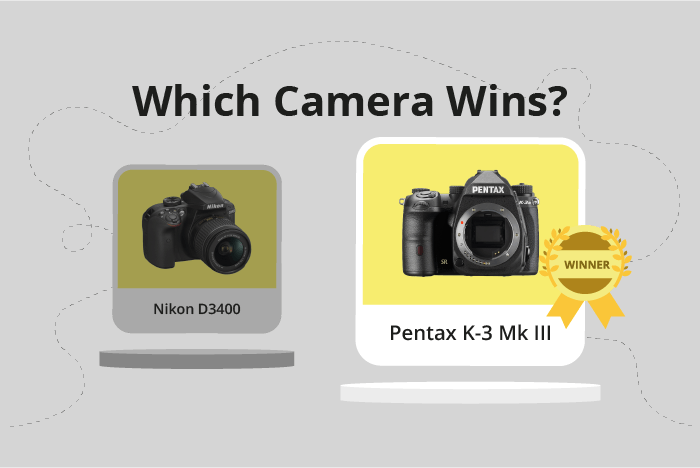Nikon D3400 vs Pentax K-3 Mark III Comparison
Nikon D3400

Pentax K-3 Mark III

The Pentax K-3 Mark III outperforms the Nikon D3400 with a score of 83/100 compared to 61/100. Both cameras are DSLRs, released in 2021 and 2016, respectively. They share similarities in size, with the Nikon measuring 124 x 98 x 76mm and the Pentax at 135 x 104 x 74mm.
The Pentax K-3 Mark III excels with its higher score, reflecting its superior performance and features. However, the Nikon D3400 has its advantages, such as a lighter weight of 445g compared to the Pentax’s 820g, making it easier to carry around.
Considering the price difference, the Nikon D3400 launched at $650, while the Pentax K-3 Mark III has a higher launch price of $1999. This reveals that the Pentax K-3 Mark III offers more advanced features and better performance, but at a higher cost. The Nikon D3400 is a more budget-friendly option with decent performance for casual photographers.
Nikon D3400 vs Pentax K-3 Mark III Overview and Optics
The Pentax K-3 Mark III outperforms the Nikon D3400 in optics, with a score of 82/100 compared to the Nikon’s 65/100. Both cameras feature a CMOS sensor and an APS-C sensor size. They also share similarities in their lens mounts, with the Nikon utilizing an F DX mount and the Pentax using a KAF2 mount.
The Pentax K-3 Mark III has several advantages over the Nikon D3400. It boasts a higher megapixel count at 26 compared to the Nikon’s 24.2, which allows for greater detail in images. The Pentax also has a faster shooting speed of 12 frames per second, doubling the Nikon’s 5 frames per second. Additionally, the Pentax K-3 Mark III has a superior DXOMARK sensor score of 96, while the Nikon D3400 scores 86. The Pentax camera also offers image stabilization, a feature absent in the Nikon D3400.
On the other hand, the Nikon D3400 has a slightly faster processor, the Expeed 4, compared to the Pentax’s Prime IV processor. However, this advantage does not significantly impact the overall performance of the camera in terms of optics.
Taking these factors into consideration, it is evident that the Pentax K-3 Mark III provides superior optics compared to the Nikon D3400. With a higher megapixel count, faster shooting speed, better DXOMARK sensor score, and image stabilization, the Pentax camera is a better choice for those prioritizing image quality. Although the Nikon D3400 has a faster processor, this advantage does not outweigh the benefits offered by the Pentax K-3 Mark III.
Nikon D3400 vs Pentax K-3 Mark III Video Performance
The Pentax K-3 Mark III outperforms the Nikon D3400 in video capabilities, scoring 83/100 compared to the D3400’s 56/100. This significant 27-point difference highlights the superior features of the K-3 Mark III in video recording.
Both cameras share some common video specifications, such as the maximum video frame rate of 60fps. This allows for smooth video playback and the ability to create slow-motion footage. However, the similarities end there, as the K-3 Mark III boasts superior specs in other aspects.
The Pentax K-3 Mark III has a maximum video resolution of 4K (3840 x 2160), which is much higher than the Nikon D3400’s Full HD (1920 x 1080) resolution. This higher resolution offers increased detail and clarity in the recorded footage, making the K-3 Mark III a better choice for those seeking professional-quality videos. Additionally, the K-3 Mark III has built-in time-lapse functionality, allowing for creative time-lapse videos without the need for external accessories or software.
The Nikon D3400, on the other hand, does not have any clear advantages in video capabilities compared to the Pentax K-3 Mark III. Its lower resolution and lack of time-lapse functionality make it a less competitive option for videography.
Comparing the video capabilities of these two cameras, the Pentax K-3 Mark III stands out as the clear winner with its 4K resolution and built-in time-lapse feature. The Nikon D3400 falls short in this aspect, making it a less suitable choice for those prioritizing video performance.
Nikon D3400 vs Pentax K-3 Mark III Features and Benefits
The Pentax K-3 Mark III wins the features comparison with a score of 87/100, while the Nikon D3400 scores 54/100. Both cameras share some specifications, including a lack of GPS and flip screen. However, the Pentax K-3 Mark III outperforms the Nikon D3400 in several aspects.
The Pentax K-3 Mark III has a larger screen size of 3.2 inches compared to the Nikon D3400’s 3 inches. Additionally, the screen resolution is significantly higher at 1,620,000 dots, as opposed to the Nikon D3400’s 921,000 dots. This results in a clearer and more detailed display on the Pentax K-3 Mark III. The winning camera also features a touchscreen, which the Nikon D3400 lacks. The touchscreen allows for more intuitive navigation and control.
Connectivity is another area where the Pentax K-3 Mark III excels. It has both Wi-Fi and Bluetooth capabilities, while the Nikon D3400 only has Bluetooth. The presence of Wi-Fi enables easier file transfers and remote control of the camera.
The Nikon D3400 does not have any significant advantages over the Pentax K-3 Mark III in terms of features. Its lower score reflects the lack of advanced features compared to the winning camera.
To conclude, the Pentax K-3 Mark III is a superior camera in terms of features, with a higher score, larger and higher-resolution screen, touchscreen capability, and Wi-Fi connectivity. The Nikon D3400 falls short in these aspects, making the Pentax K-3 Mark III the better choice for photographers seeking advanced features.
Nikon D3400 vs Pentax K-3 Mark III Storage and Battery
The Pentax K-3 Mark III outperforms the Nikon D3400 in storage and battery, scoring 81/100 compared to the D3400’s 45/100. Both cameras accept SD, SDHC, and SDXC memory cards, but the K-3 Mark III has an advantage with two memory card slots, one of which is UHS-II compatible, offering faster data transfer.
The Nikon D3400 has a longer battery life, providing 1200 shots per charge with its EN-EL14a battery, while the Pentax K-3 Mark III offers 800 shots with its D-LI90 battery. However, the K-3 Mark III compensates for shorter battery life by supporting USB charging, a feature absent in the D3400.
In terms of storage and battery, the Pentax K-3 Mark III holds an edge with dual memory card slots and USB charging capabilities. On the other hand, the Nikon D3400 offers longer battery life. Ultimately, the K-3 Mark III is the superior choice for those prioritizing storage flexibility and convenient charging, while the D3400 is more suitable for users seeking longer battery life.
Nikon D3400 vs Pentax K-3 Mark III – Our Verdict
Are you still undecided about which camera is right for you? Have a look at these popular comparisons that feature the Nikon D3400 or the Pentax K-3 Mark III:

